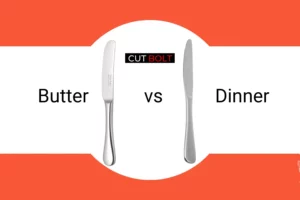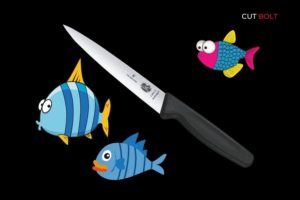At first glance, a Santoku knife and a Chef’s knife may seem alike to the casual cook.
However, these two popular kitchen knives have significant differences that are crucial to understand before making a purchase decision.
In this blog post, we’ll take a closer look at Santoku knives and chef knives, explore their unique features and advantages, and help you decide which one is right for you.
If you don’t have time to read the entire article, here is a snapshot of the basic differences:
| Chef’s knife | Santoku |
| Bigger, heavier, more robust | Shorter, lighter, handier |
| Standard length 20 cm | Length usually 15-18 cm |
| Thicker cutting edge = more splitting effect | Thinner = better cutting properties |
| Grinding angle is usually 10-15° | The grinding angle is usually 10-15° |
| Good for men | Better for women |
| More resistant cutting edge | More delicate edge |
| For professionals & hobby cooks | Rather for amateur cooks |
- What is a Santoku knife?
- What is a Chef knife?
- Key differences between Santoku and Chef’s knife
- Chef knife vs Santoku knife: Differences in features
- Chef knife vs Santoku knife: Differences in designs
- Best uses: Santoku knife vs Chef knife
- Taking care: Chef knife vs Santoku knife
- Conclusion: Differences between Santoku and Chef knife
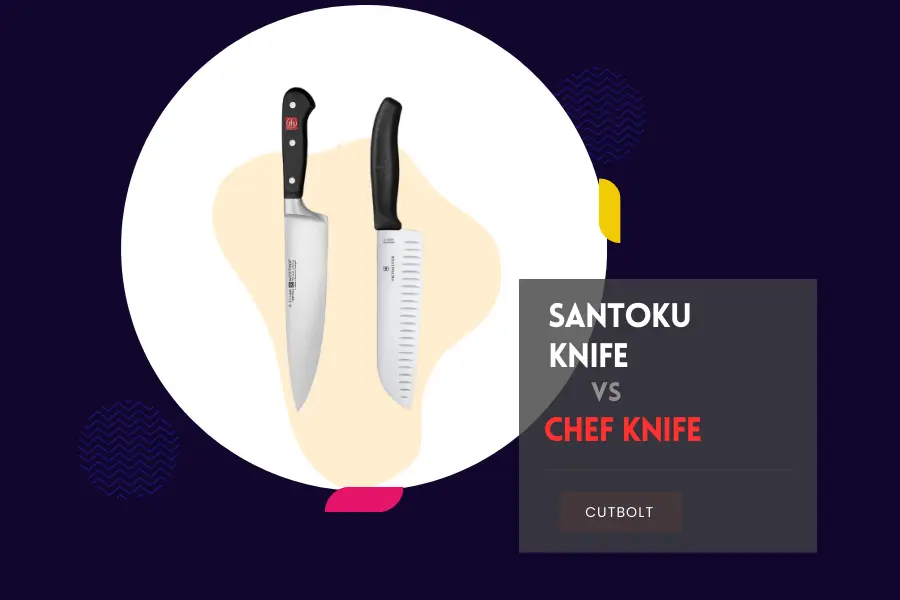
What is a Santoku knife?
A Santoku knife is a Japanese-style knife that is typically shorter and lighter than a Chef’s knife. It has a straighter blade, usually featuring a granton edge or scallops along the blade’s sides to prevent food from sticking.
Santoku knives are ideal for precise slicing, dicing, and mincing tasks, making them a favorite among Asian cuisine chefs.
Properties and characteristics of Santoku knives
The Santoku knife was developed by the Japanese in the 1940s, after World War II, and is a hybrid of the gyuto (meat), the nakiri (vegetable) and the deba (fish). It was developed as an all-purpose knife for (Japanese) domestic use in the wake of the increasingly popular European chef’s knife and was intended to replace (in private households) the Gyuto, Nakiri and Deba.
Due to its popularity in the West, the santoku has been constantly adapted and developed, so modern santokus are often a mixture of the traditional santoku and the European/Western chef’s knife.
- Often hand-forged
- Slightly downward-pointing, rounded tip
- Blade length between 15-18 cm
- Blade steel between 55-62+ HRC (Western manufacturers use softer steel, Japanese manufacturers use harder steel)
- Grinding angle between 10-15°
- A relatively straight or only very slightly rounded blade
- thin blade
- Traditional Santokus often have a glued wooden handle, European Santokus often have a riveted plastic handle with a continuous tang
- No goiter
- Often with a hollow edge
What is a Chef knife?
On the other hand, a Chef’s knife, also known as a French knife, is a versatile kitchen tool with a longer and wider blade.
It has a curved blade that is perfect for rocking back and forth for effortless chopping, slicing, and mincing.
A Chef’s knife is suitable for various cutting tasks, including chopping vegetables, meat, and fish, making it a must-have for every home cook and professional chef.
It’s vital to consider your specific cutting needs when choosing between a Santoku knife and a Chef’s knife.
If you’re into precise and delicate slicing tasks like sushi or sashimi, a Santoku knife is your best bet.
But if you’re looking for a versatile kitchen knife that can handle most of your cutting tasks, a Chef’s knife is a perfect choice.
Properties and characteristics of chef’s knives
The cornerstone for the modern chef’s knife as we know it today was laid in 1731 when Peter Henckels founded the Zwilling company. Since then, many other manufacturers have joined and there have been a number of innovations and improvements, but the core of the (European/Western) chef’s knife has remained intact to this day.
Chef’s knives usually have the following properties:
- Forged, usually in one piece
- Mostly machine made & processed
- Relatively soft stainless steel between 54-59 HRC
- Blade length between 16-30 cm, with 20 cm being the standard length of most chef’s knives
- Grinding angle is usually between 15-20°
- Pointed tip
- Slightly rounded blade, especially at the front of the blade belly
- Straight & relatively wide spine of the blade
- Continuous Permission
- Riveted handle (usually made of plastic)
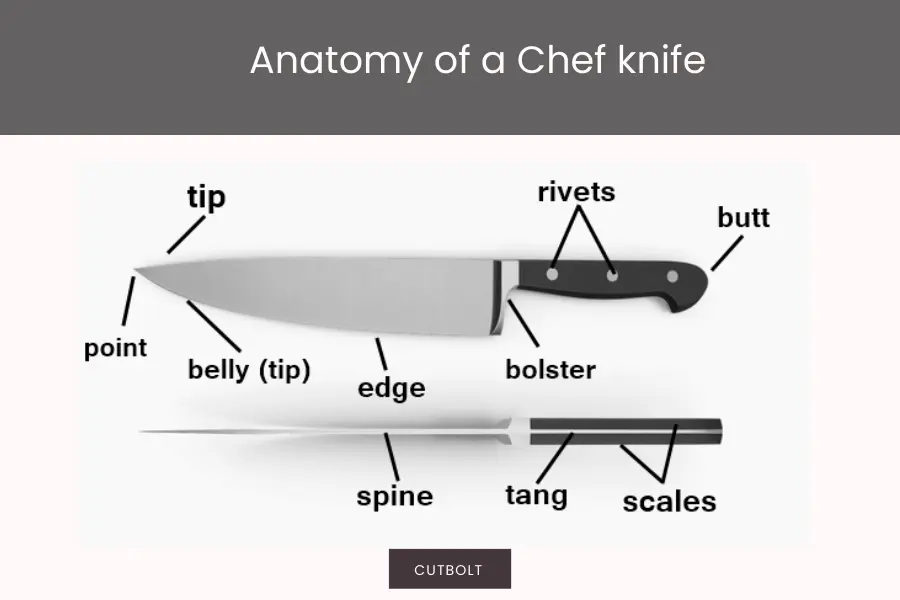
We have discussed about Chef knife vs Steak knife, it will be helpful for you to know.
Key differences between Santoku and Chef’s knife
The first difference is their origin. The Santoku knife originates from Japan, while the Chef’s knife has French roots.
The Santoku was designed specifically for slicing, dicing, and mincing vegetables, while the Chef’s knife was intended to handle a broader range of tasks, including meat and fish.
The second difference lies in the blade shape.
A Santoku knife typically has a shorter, thinner blade than a Chef’s knife. Its blade is straighter, with a more gradual curve near the tip.
It allows precise cuts and is ideal for intricate tasks like cutting sushi or preparing sashimi.
On the other hand, a Chef’s knife has a longer, wider blade with a more pronounced curve. This design allows for a rocking motion while chopping, making it easier to cut through denser ingredients like meat.
Lastly, the type of cut or slice one can achieve varies between the two knives.
The Santoku knife’s straighter blade is perfect for making clean, precise cuts, while the Chef’s knife’s curved blade allows for a rocking motion that makes it easier to chop and slice quickly.
Chef knife vs Santoku knife: Differences in features
Features of Santoku knife
The Santoku knife, with its unique features, has earned its place in many kitchens around the world.
Here is a list of those features:
- Originated in Japan, making it a distinctive addition to your knife collection.
- Wide sheepsfoot blade with no tip, which curves down to meet the straight-edged front blade, allowing for versatile use in chopping, slicing, and mincing.
- Thinner blade compared to the Chef’s Knife, making it perfect for precision tasks such as refined slicing.
- Available in single or double bevel, which refers to the surface that has been ground to form the knife’s edge, providing versatility for all your cutting needs.
- Usually no bolster, the piece of metal between the blade and handle, which ensures balanced weight distribution and makes the knife lighter and easier to maneuver.
- Balanced weight, providing more control and comfort during use.
- Lighter to hold, minimizing fatigue and increasing efficiency during long prep sessions.
- May have a granton edge, which consists of small divots or scallops on the blade, to prevent food from sticking and enable smoother cuts.
- Varies in size from 5 to 7.9 inches, providing options to suit different needs and preferences.
The Santoku knife’s unique features, from its blade design to its weight and size options, make it a must-have in any kitchen. Whether you are a professional chef or a home cook, a high-quality Santoku knife will elevate your culinary experience and take your dishes to the next level.
Features of a Chef knife
The Chef’s Knife is a staple in most kitchens, renowned for its versatility and durability. Here are some of its key features:
- Originated in Germany and France, bringing a rich history and tradition to your culinary experience.
- Broad blade that curves upwards to form a tip, with a thicker spine to add weight and stability during cutting.
- Comes in serrated varieties, allowing for effortless slicing of tougher or crustier foods such as bread or meat.
- Usually only found in double bevel, providing a sharp and precise edge for all your cutting needs.
- Has a bolster, the piece of metal between the blade and handle, providing extra weight and balance for comfortable use.
- Heavier to hold than the Santoku knife, providing more power and control when cutting through denser or tougher ingredients.
- May feature a granton edge, with small divots or scallops on the blade to prevent food from sticking and enable smoother cuts.
- Varies in size from 6 to 12 inches, with the 8-inch size being the most popular among home cooks, while many professionals opt for 10 or 12 inches for added versatility.
With its broad blade and serrated varieties, the Chef’s Knife is an ideal tool for slicing, dicing, chopping, and mincing. Its heavier weight and bolster design provide extra control and power, making it an indispensable addition to any kitchen.
From beginner cooks to seasoned professionals, the Chef’s Knife is a must-have for any culinary enthusiast looking to elevate their dishes and create impressive culinary masterpieces.
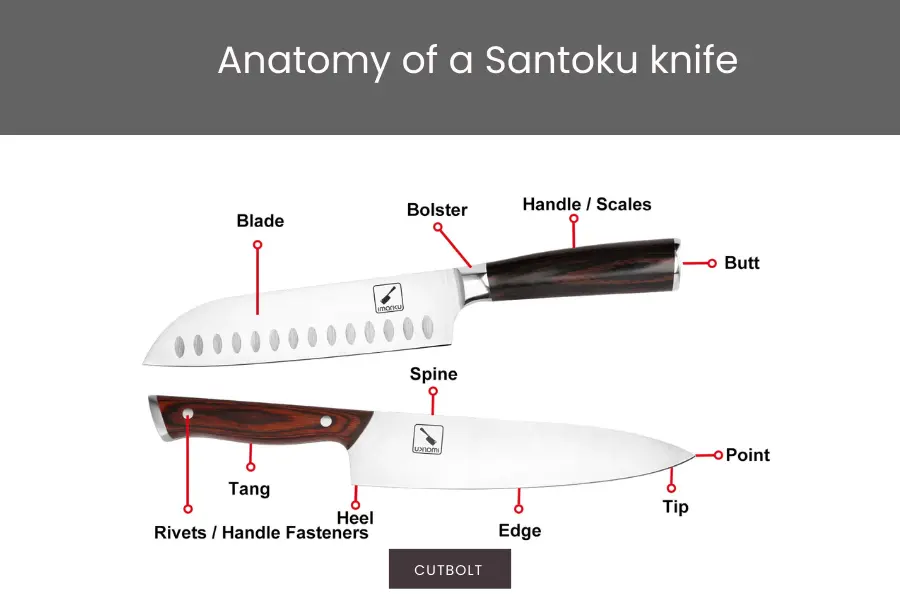
Chef knife vs Santoku knife: Differences in designs
Design and Features of a Chef knife:
- Blade Length: A typical Chef knife has a blade length of 8-10 inches, which is longer than a Santoku knife.
- Blade Shape: The blade of a Chef knife is curved, which makes it easier to rock the blade back and forth for efficient chopping and slicing.
- Blade Thickness: The blade of a Chef knife is thicker than a Santoku knife, which provides more weight and stability for chopping through thicker meats and vegetables.
- Blade Edge: The edge of a Chef knife is curved, which makes it more suitable for slicing than chopping.
- Handle: The handle of a Chef knife is typically longer and wider than a Santoku knife, which provides a comfortable grip for users with larger hands.
Design and Features of a Santoku Knife:
- Blade Length: A typical Santoku knife has a blade length of 5-7 inches, which is shorter than a Chef knife but longer than a paring knife.
- Blade Shape: The blade of a Santoku knife is flat and has a sheepsfoot shape, which means that the spine of the blade curves down to meet the edge at the tip. This design makes it easier to slice food with a rocking motion.
- Blade Thickness: The blade of a Santoku knife is thinner than a Chef knife, which makes it more lightweight and easier to handle.
- Blade Edge: The edge of a Santoku knife is usually straight instead of curved, which makes it more suitable for chopping than slicing.
- Handle: The handle of a Santoku knife is typically shorter than a Chef knife and has a straighter shape, which provides a comfortable grip for users with smaller hands.
Advantages and Disadvantages of a Chef knife:
- Advantages: The Chef knife is a versatile all-purpose knife that can handle a wide variety of tasks, from chopping and slicing to mincing and dicing. Its curved blade shape makes it easier to rock the blade back and forth for efficient chopping and slicing. It is also suitable for tasks such as breaking down poultry and cutting through thicker meats with bones.
- Disadvantages: The Chef knife is heavier and less maneuverable than a Santoku knife, which can make it more difficult to handle for users with smaller hands. Its curved blade edge may also make it less suitable for chopping tasks.
Advantages and Disadvantages of a Santoku Knife:
- Advantages: The Santoku knife is well-suited for chopping, slicing, and dicing vegetables, fruits, and boneless meats. Its flat blade shape makes it easier to cut straight down and its thinner blade makes it more lightweight and maneuverable than a Chef knife.
- Disadvantages: The Santoku knife is not as versatile as a Chef knife, as it is not suitable for tasks such as breaking down poultry or cutting through thicker meats with bones. The straight blade edge also makes it less suitable for slicing tasks.
Recommended Brands and Models of Santoku knife:
- Shun Classic Santoku Knife
- Global G-48 7-Inch Santoku Knife
- Wusthof Classic 7-Inch Santoku Knife
Recommended Brands and Models of Chef knife:
- Wusthof Classic 8-Inch Chef Knife
- Shun Classic 8-Inch Chef Knife
- Global G-48 8-Inch Chef Knife
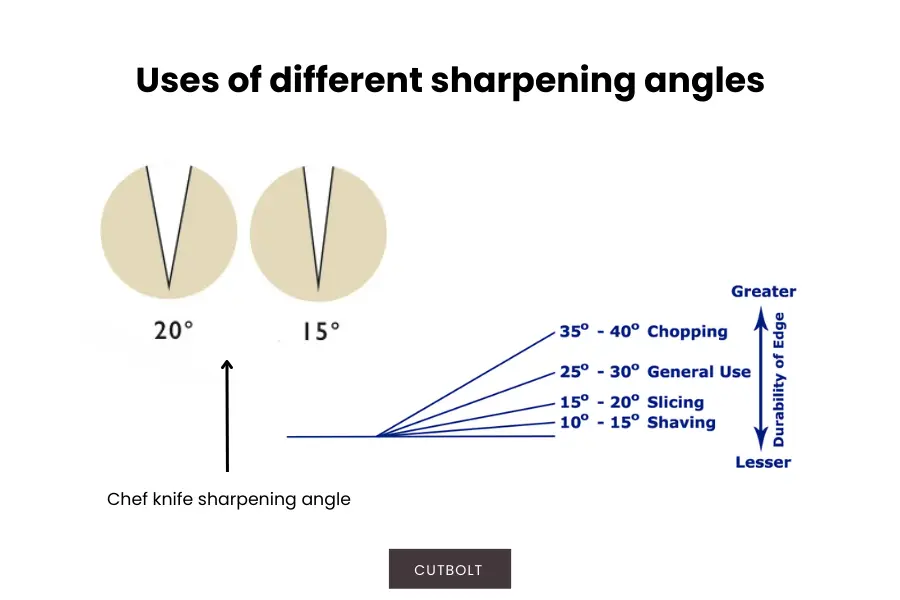
Best uses: Santoku knife vs Chef knife
The Santoku knife is aptly named as it excels in three key areas: chopping, dicing, and mincing – the three virtues.
It expertly performs these tasks with precision and efficiency, making it an indispensable tool in any kitchen. However, it’s not suitable for chopping large meat bones, slicing bread, or undertaking tasks that require exceptional precision, such as peeling.
The Santoku knife is especially useful in creating very thin slices of food, which enhances the visual appeal of the final dish.
Best uses of a Santoku knife:
- Cutting various types of meat with ease
- Slicing through cheese like butter, without sticking or tearing
- Efficiently slicing, chopping or dicing fruits, vegetables, and nuts with precision
- Mincing meat or herbs quickly and effectively
- Scooping food off a cutting board with ease, thanks to its wide blade
- Creating fine and delicate slices, especially useful for vegetables and seafood dishes.
Given that the Santoku knife has a shorter length than a standard Chef’s Knife, measuring at 8 inches in length, and a handle-to-blade design that is seamless, it is an ideal choice for those with smaller hands.
A Chef’s Knife is the go-to tool for professional chefs due to its versatility in the kitchen. It can handle a wide range of tasks, including complex cutting, slicing and disjointing meat, slicing cheese, and chopping or dicing fruits, vegetables, and nuts. However, it is not recommended for chopping large meat bones, frozen products, or intricate peeling and julienning jobs.
Best uses of a Chef’s Knife:
Here are some of the best uses for a Chef’s Knife:
- Complex or versatile cutting
- Cutting, slicing, and disjointing meat (the tip is well suited to separating chicken parts)
- Slicing cheese
- Slicing, chopping, or dicing fruits, vegetables, and nuts
Note that while a Chef’s Knife can handle many tasks admirably, it may not be as effective as a Santoku knife for creating very fine slices.

Taking care: Chef knife vs Santoku knife
Proper care is essential for ensuring your knives last for a long time. This involves cleaning, sharpening, and storing them correctly.
Both Santoku and Chef’s Knives should be hand washed and dried with a soft, clean towel to avoid damage. It is advisable to avoid using dishwashers or scourers and opt for a wooden box or block for storage.
The crucial difference in caring for these knives lies in the sharpening methods employed.
Sharpening: Difference between Santoku knife and Chef knife
Sharpening a knife is essential to maintaining its effectiveness and longevity. Here are three critical reasons to sharpen your knives regularly, before discussing the differences in sharpening between a Santoku and Chef’s Knife:
- Safety: Dull knives can be dangerous as they require more force to cut, increasing the risk of injury.
- The right finish: Sharp knives maintain the quality and appearance of the food being prepared.
- Pleasure: Cooking with a sharp knife is a more enjoyable experience.
How to sharpen Santoku knife?
Sharpening a Santoku knife is crucial to maintain its performance and longevity. Due to their single bevel and harder steel, it is easier to achieve a finer angle on the blade, resulting in a sharper knife. The ideal angle for sharpening a Santoku knife is between 10-15 degrees.
Compared to double-bevel knives, single-bevel Santoku knives require less sharpening work. Additionally, Santoku knives don’t have a bolster, making them easier to sharpen.
To sharpen a Santoku knife effectively, it is recommended to use a whetstone. This method provides a sharper knife edge compared to other methods. However, it is crucial to follow the detailed instructions supplied with your whetstone.
- Submerge and soak whetstone in water
- Using the coarse side first, tilt the knife at the correct angle
- Run the knife up and down the stone in a smooth motion
- Ensure the whole blade is covered from the edge to the start of the handle
- Repeat the process on the other side if the knife is double-beveled
- Flip the stone to the finer side and repeat again
- Thoroughly wash and dry the knife
Note: Japanese knives are made from thinner steel. They are strong but can get damaged if sharpened using a sharpening rod.
How to sharpen Chef’s knife?
When it comes to sharpening a Chef’s Knife, the preferred method for achieving a defined and highly sharpened edge is whetstone sharpening.
The ideal angle for sharpening a Chef’s Knife is between 15 to 20 degrees on both sides. However, in between bouts of sharpening, some may opt to use steel to hone the knife. If you choose to use a honing steel, it is essential to follow the manufacturer’s instructions carefully and take your time when practicing.
Sharpening steps for a Chef knife:
- Hold the Chef’s Knife handle in your dominant hand and the honing steel in the other, both pointing upwards to form a V-shape.
- Place the blade’s heel against the steel at a distance of approximately 2cm from the top of the steel, ensuring the correct angle (around 15 – 20 degrees).
- Draw the blade down the steel, towards the tip of the blade, with medium pressure. Move the knife down the steel while maintaining the angle, ensuring only the edge comes in contact with the steel, not the side.
- Repeat this process 5 to 10 times on each side of the blade. Remember, consistency in maintaining the correct angle is more important than speed.
Conclusion: Differences between Santoku and Chef knife
The choice between a Santoku knife and a Chef knife ultimately depends on personal preferences and the specific requirements of the task at hand.
While the Santoku knife is better suited for precise chopping and slicing of vegetables and fruits, the Chef knife is more versatile and can handle a wider variety of tasks.
When selecting a knife, you should consider factors such as blade length, blade shape, blade thickness, blade edge, and handle design to ensure that the knife meets your specific needs.
It’s also important to select a high-quality brand and model of a knife to ensure that it lasts for years to come.

